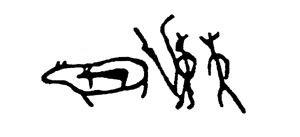Siberia - the Medieval Invaders
In 1235 King Béla IV of Hungary sent an expedition of four Dominicans to find the other Hungarians of Greater Hungary.
In 896, several Magyar and three Khazar tribes had migrated from what is now southern Russia, to where Hungary is now. The Khazar were Jewish, part of the Khazar empire, the Magyar still had their traditional beliefs, but in the 11th century had been officially converted to Catholic.
The Dominicans now wanted to convert the Hungarians who remained in Greater Hungary. An earlier expedition had found out where this was. East of the Volga. By 1236, only Friar Julian, the leader of the second expedition had survived to reach Great Hungary. Here he found the people spoke Hungarian - they could understand each other. (The remains of this nation are the Voguls (Mansi) in the Urals.)
By chance, Friar Julian had arrived at the same time as an Ambassador from the Great Khan. In Europe, as yet little was known of the Mongol conquests which were pushing on into Europe until the Mongol empire was to reach from the Pacific to the Adriatic. It was already international. Genghis Khan and his successors knew the value of making use of other's talents.
The Khan's ambassador, was English, and not the only Westerner to be employed at the Mongol courts - they employed the world's best, craftsmen, diplomats, etc. The Khan's English diplomat was brilliant at languages. He was there to warn the nations east of the Volga - the Bulgars and Hungarians that they should "submit or be destroyed". He warned Julian that he should return immediately to Hungary and tell his King to be prepared for invasion.
In the 13th century - the rise of the Mongol empire drove new populations of people north into Siberia. At this time Western and southern Siberia - and Eastern and Northern Europe were occupied by people speaking Finno-Ugrian languages related to Finnish and Hungarian. In the South of Siberia were people with horses and cattle speaking Turkic-Mongolian languages. North of China were people speaking Tungus-Manchurian languages - amongst them the Cherchen who ruled the North of China until conquered by the Mongols.
In the far east and along the North Pacific coasts were people speaking languages related to the Inuit, Chukchi, Koryak to the south of them, and people of Kamchatka and part of Japan - and the Inuit themselves had spread during warmer climatic conditions from the far east of Chukotka across the arctic north of Canada and to Greenland. The Inuit in Greenland survived the colder weather while their Viking neighbours perished. The Chukchi were a federation of tribes - one of which was the Laurovetlan - the original name for their land it is thought - another was called the Chuvantsi, and another Kanglalenci - they have vanished.
The Federation was in defence against the Tungus moving north up the Pacific coast - now called Even - then called Lamut (meaning sea people). Early history of the Amur and Pacific coast region here.
Some language groups have defied attempts to classify them. The Yukaghirs in the 16th century occupied the whole north of Yakutia. Their appearance then and their customs (such as the "George" or chest sun medallion worn on the front of their aprons) show a connection with what we think of as Europeans. This does not mean a European origin as many Europeans originated in Asia. Certainly they are linked by language and customs to Uralic people who are now in North-East Europe, West and Central Siberia. They could not have lived in total isolation for they had iron working - and the earliest date of that is about 2,500 years ago. They have also been linked to the Dene of Alaska and North America.
Yukaghir was from the Tungus meaning something like "far off tribe" - their own name for themselves was Odil (or similar) as a number of dialects.
By the 17th century, the Lamut (Even) were mixing with the Yukaghir and dominated their culture. By the end of the 19th century there were only about a hundred Yukaghir speakers left and many of those were Lamut (Even). The language survived as it was picked out after the revolution to be taught in local schools and and the alphabet adapted for it. A Yukaghir writer said he must be one of the few who knew all his readers. But the number of Yukaghir speakers rose to about 800 in the 20th century as a result of the preservation of their language. The few people left who can claim to be Yukaghir though now look like the Even.
 The Yukaghir used dog sleds for transport (this is mentioned by Marco Polo). They hunted wild reindeer. In the autumn when the reindeer returned south from their summer pastures on the tundra - the Yukaghir would be waiting for them as they crossed a river and move in for the kill. They lived in small villages along the rivers. In half-underground houses in winter and large round tents in the summer.
The Yukaghir used dog sleds for transport (this is mentioned by Marco Polo). They hunted wild reindeer. In the autumn when the reindeer returned south from their summer pastures on the tundra - the Yukaghir would be waiting for them as they crossed a river and move in for the kill. They lived in small villages along the rivers. In half-underground houses in winter and large round tents in the summer.
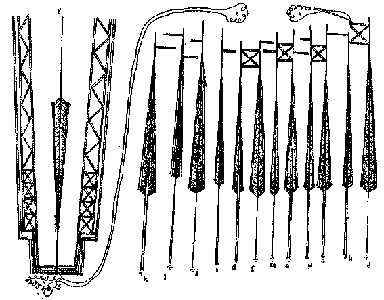 They had a pictorial writing system with which they recorded events and stories - and another writing system used by girls to court the men they fancied - an example is shown in the picture. Their boyfriend would move in with them and had to work for his father-in-law.
They had a pictorial writing system with which they recorded events and stories - and another writing system used by girls to court the men they fancied - an example is shown in the picture. Their boyfriend would move in with them and had to work for his father-in-law.
In the home only certain family members were allowed to speak to each other. These arrangments were very formal and failure to observe the conventions caused trouble.
Each clan had a shaman (usually a woman but not necessarily) - on whom they depended. When the clan shaman died, her body was cut up and preserved in reliquaries as talismans.
Each community had its head man and his wife, the chief hunter and his wife, the main warrior and his wife and so on. The hunters did not return with the kill, they told the women where it was and the women brought it back and distributed the meat in the correct manner amongst the others.
Even/Lamut

Although the Evens/Lamuts also used dog sleds for transport - harnessed differently to the Yukaghir way but like those in the Amur region, they rode reindeer like the Evenks - saddled well forward over the animals's shoulders as reindeer have weaker backs than horses. Their neighbours the Chukchi and Koryaks used reindeer to pull sleds but did not ride them. In fact riding reindeer that way is difficult if you are not used to it - it is a bumpy ride and even the Tungus sometimes carried a staff to help get onto the saddle and keep their balance while going along and holding the reins.
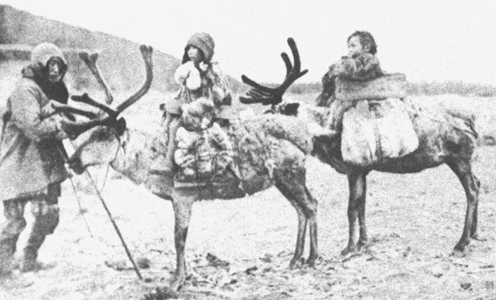 Small children were attached to the reindeer backs in a device rather like the way children today are strapped into a car seat - similar shape etc. While babies were carried in a cradle very much like the car carriers for babies today. They were angled - had handles to carry them by. And they were padded with a disposable mattress of moss. The same sort of equipment was used by the Evenks of central Siberia.
Small children were attached to the reindeer backs in a device rather like the way children today are strapped into a car seat - similar shape etc. While babies were carried in a cradle very much like the car carriers for babies today. They were angled - had handles to carry them by. And they were padded with a disposable mattress of moss. The same sort of equipment was used by the Evenks of central Siberia.
The Evens herded reindeer while the Yukaghir only hunted them, but otherwise they also lived by hunting and fishing. The women would go collecting berries and plants for eating. On the Okhotsk coast, where the Lamuts (Even) originally lived, (hence Lamut (sea people)they hunted seals with harpoons like the Tungus peoples further south along the Pacific coast. They used wooden boats and all the hunters wore white overcoats as camouflage in winter. The Even on the Okhotsk coast also kept horses.
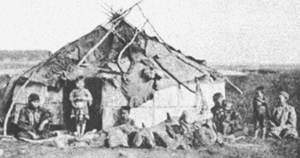 Even lived either in small tents like the Evenks, or in the larger chorama-dyu like the Yukaghirs. Up to the 18th century they still lived in the tradition winter houses by the coast - half underground with the entrance through the chimney hole. They built storehouses on platforms. Their clothes were the traditional Siberian fashions as worn also by the Yukaghir and Evenks and Dolgans. They had a similar clan structure of society which became mixed with clans of other peoples they encountered.
Even lived either in small tents like the Evenks, or in the larger chorama-dyu like the Yukaghirs. Up to the 18th century they still lived in the tradition winter houses by the coast - half underground with the entrance through the chimney hole. They built storehouses on platforms. Their clothes were the traditional Siberian fashions as worn also by the Yukaghir and Evenks and Dolgans. They had a similar clan structure of society which became mixed with clans of other peoples they encountered.
The Dolgans in the north of Central Siberia are much targeted by ethnographers but seem to have been a recent tribe made up of people of many different origins stranded in the far north arctic coast and adopting traditional Siberian ways, customs, clothes and lifestyle for survival.
Evenk
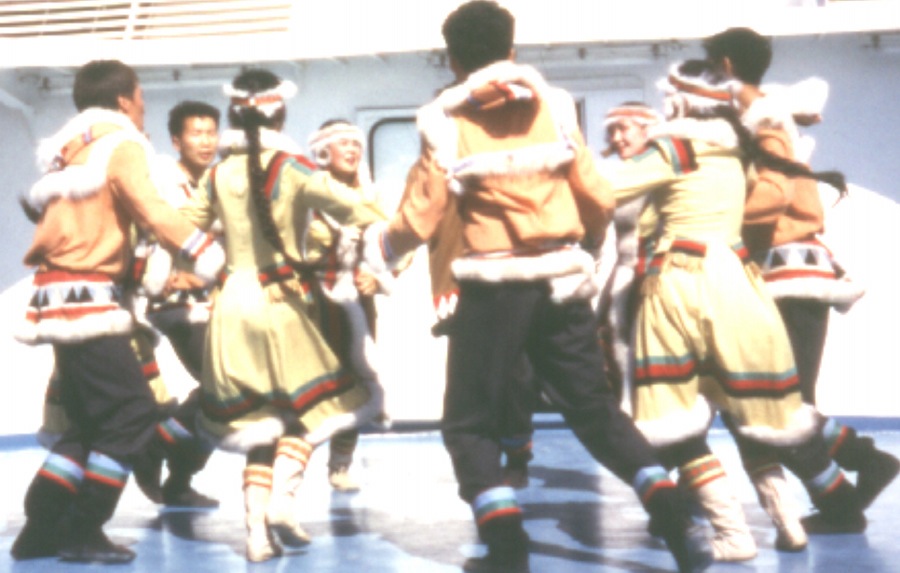
The Evenk live mainly in Siberia - and also North China. Traditionally they were mainly nomadic hunters and reindeer herders.
The language is Tungus-Manchurian group.
There are about 30,000 in the Russian Federation (including Evenkia and Yakutia mainly) and 26,000 in China.
Related to Evenk are Even (Lamut) - who number about 17,000 mostly in the Siberian Far East) and Orochen in North China - about 7,000).
Their origin was about Lake Baikal.
1811 Russian Government organised administration of Evenks (Tungus) to ensure collection of fur ax and political control. Collecting furs did not feed them and many became very poor with no reindeer, dependant on wealthier people for work or charity, or forced to look for another way of life - many starved.
1930s - Collectivisation began along with attempt to settle Evenk into towns.
1970 collectives restructured into state farms. Evenkia now included the Kets by the Yenisei and immigrants, Russian, Ukrainian, Balts and Germans, here to exploit mineral resources and other forms of industry and agriculture.
But when fur went out of fashion, hunting was no longer a viable way of living.
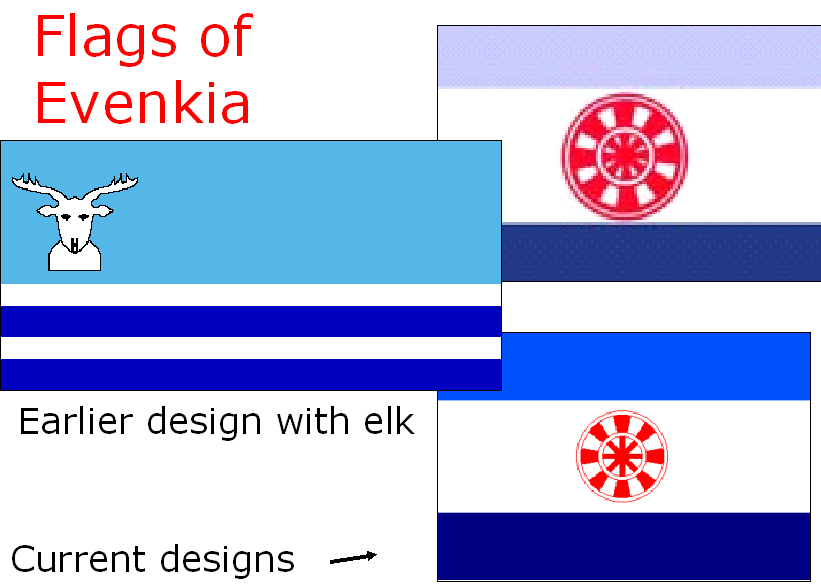 1991 Evenkia formed from Evenk and Karasnoyarsk as republic in the Russian Federation. The design of the national flag changed a few times.
1991 Evenkia formed from Evenk and Karasnoyarsk as republic in the Russian Federation. The design of the national flag changed a few times.
1994, became member of Northern Forum.
The country still has wild areas of taiga. There is no railway connects north of Krasnoyarsk, and no real roads. Transport depends on aircraft, river boats in summer, and frozen winter roads with really tough lorries. Motor driven sleds. And they still ride reindeer.
The two main rivers - both tributaries of the Yenesei, the Nizhnyaya Tunguska, and Podkamennaya Tunguske is their mighty rapids. Large boats can only get through in the spring floods.
Aircraft is the main means of transport but it is expensive.
In the 1980's many towns still did not have telephone connections. Communication satellites enabled reindeer herders to watch portable television in their tents. And makes internet access possible now. But they do not have a reliable electricity supply. Radio has been the main means of communication.
In the villages and towns, central heating is produced by a central boiler house and distributed through lagged pipes. But many places even Tura the capital, have no water and sewage system. Tura still has water (which is not drinking water) supplied with tankers each day to each house. Some places water comes from the same lake in which the sewerage is dumped - hence hepatitis is increasing. Tuberculosis is still a problem.
Hunting
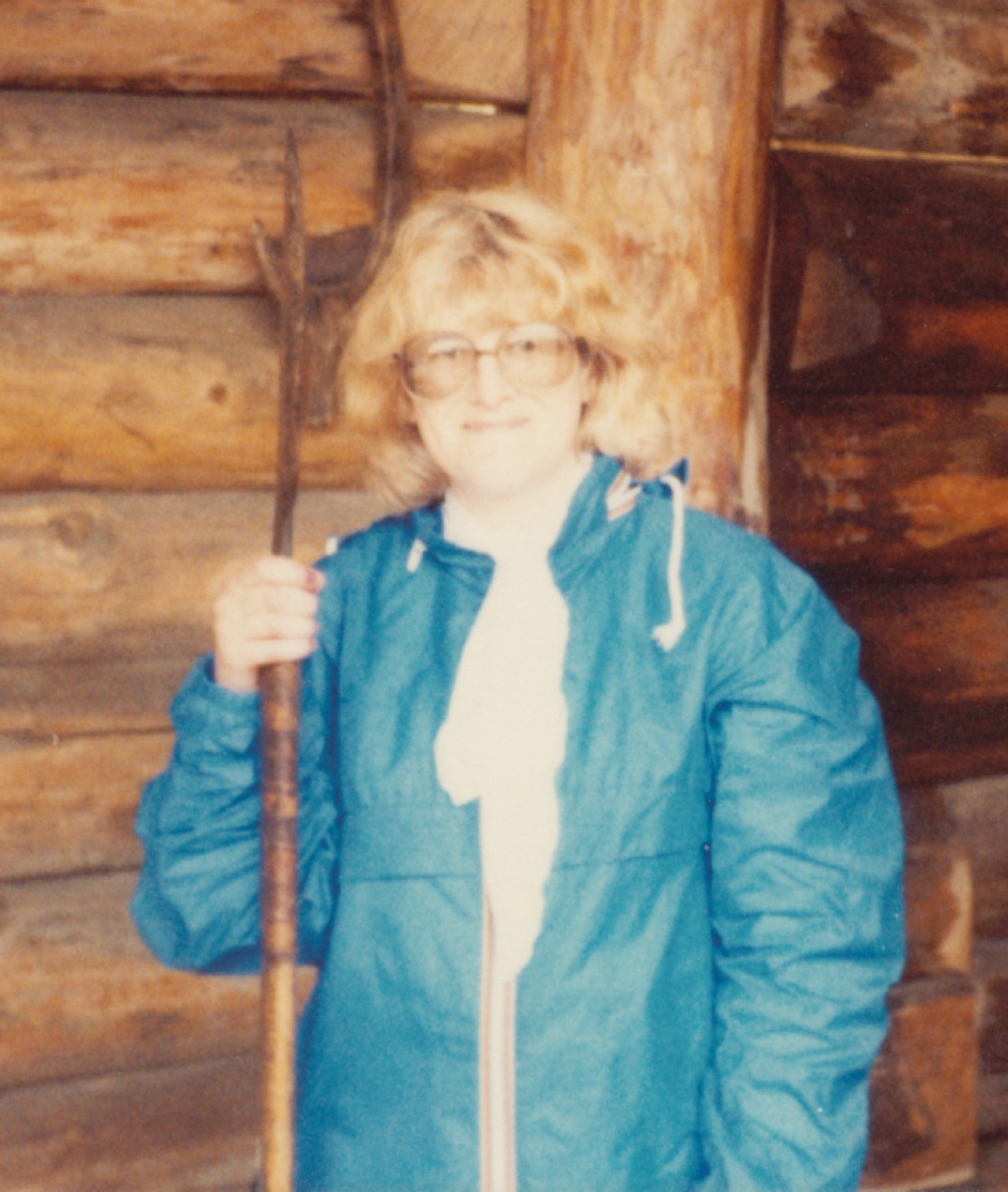 The Palma (in Russian) - Utken (in Evenk) was the Evenk main piece of equipment, a weapon and a tool. It is like a big knife on a very long pole. The picture shows me with a palma in 1983.
The Palma (in Russian) - Utken (in Evenk) was the Evenk main piece of equipment, a weapon and a tool. It is like a big knife on a very long pole. The picture shows me with a palma in 1983.
They used also to use a bow with iron arrows, even when from the 18th century, they had guns. And they would set traps for the small furry animals, sable etc.
When the men killed a bear, the women had to come and collect it and distribute the meat to everyone in the community - this was called nimat. When hunting wild deer, they attracted it with an instrument hat sounded like one. The hunter carried his stuff in a back pack and travelled on wide skis.
They had to be self sufficent, and had many crafts including blacksmith. They did not make pottery (it would not have been practical as they travelled so much) but they had Chinese porcelain. The blacksmiths made all the tools, weapons and the armour.
Food included raw marrow and raw liver. But most of the food is very nice and includes deserts made from wild berries. They also collected wild onions and garlic. And they milked the reindeer.
Reindeer quickly use up the moss on which they pasture, and have to move on. This meant they had to move home every ten days or so.
While the man went off hunting, his wife packed up all the tent onto reindeer, with special seats for the children - much like our modern carseats but made of wood and padded with moss. The reindeer were tied together to form a caravan, and riding on the first one she would take her home and children off to the next campsite.
When you look down on the Taiga Forests from a plane, you see a wilderness. The forests cover even the tops of the mountains. Settlements are along rivers. On the ground, the taiga is packed with silver birch trees and dark green larch and cedar. In summer the muddy ground is carpeted with flowers. There are no clearings and paths, the way is blocked by countless streams and lakes humming with mosquitoes. Through this the Evenks had to find their way to meet up at the next camp site, to find their reindeer pasture, fishing and hunting places, and their storage warehouses and meeting places.
Marks on trees in picture and sign writing gave indication of where to go and where people were and news about them. They also navigated by the direction of the shadows, careful observation of ground features such as the flow and contents of the rivers, the sunny or shady side of certain trees.
Just before the wife left the old campsite with her home packed up and children fastened on to her reindeer caravan - she made an offering - cloth or something similar fastened to the trees, which was to thank the Mother of that place. When the wife arrived at the site, she had to put up her home - with the poles cut for the purpose and covered with reindeer skins.
She then prayed to the Mother of that land. Everything in their Motherland, trees, mountains etc. has a Mother spirit. Over all is Mother Earth - Dunne Enin. The housewife prayed for permission from the Mother of the new place in which she was putting up her tent. Then she could make a fire in the centre of the tent and make a cup of tea. While lighting the fire she prayed to the Mother for good fortune in her new home and protection from evil spirits. She could then see to her children - the baby would be hang up in its wooden cot - which was shaped like modern baby seats. Babies were dressed in all-in-one suits much like modern babysuits except they were made from soft fur such as hare. A flap which tied up allowed for nappy changes - the disposable nappy was made from moss. Babies were weaned on reindeer milk and mash.
Women gave birth in a separate old tent which was then abandoned. The shaman helped if there was a problem. When a women had her periods she used disposable protection made of moss lining a leather thong. She had to avoid the hunters then. And could not go to a Shaman Ceremony.
In a survey in the 1930s it was found that girls tended to mature late, because of poverty and starvation. They had on average about three pregnancies one every five years. Children were at risk - from the cold, and from predators like bears. It was a hard life for women and in the 1930s only three percent lived past forty.
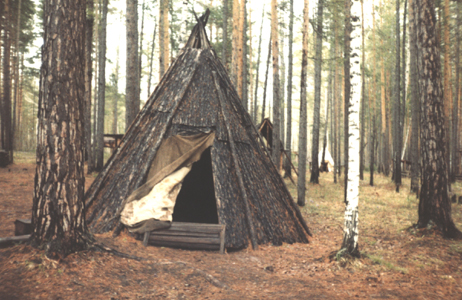 Three poles formed the main structure of the tent (called dyu) then other poles placed over them to make the round shape. This was covered with reindeer skin - or in summer, birchbark - sewn into sheets. A framework of wooden poles across the central fire were used to hand iron cooking pots and to dry clothes.
Three poles formed the main structure of the tent (called dyu) then other poles placed over them to make the round shape. This was covered with reindeer skin - or in summer, birchbark - sewn into sheets. A framework of wooden poles across the central fire were used to hand iron cooking pots and to dry clothes.
The living space was tiny and had to be very neatly and carefully arranged. The space near the entrance (changal) belonged to the wife. The space at the back (malu) was for male guests such as hunters from other families. The sides were for the rest of the family and household. They all bedded down in sleeping bags heads to outside and feet nearest the fire.
It was very smoky inside - hence they were prone to lung diseases and eye problems. The confined and isolated environment made them more prone to nervous diseases.
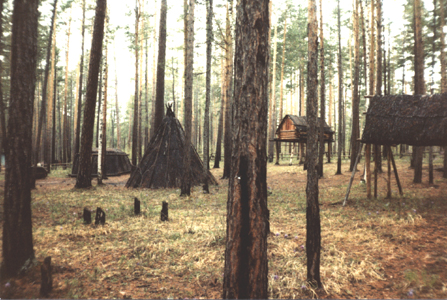 Permanent store houses were built from logs and raised from the ground on pillars - out of reach of mice. Anyone passing by could take something out of someone else's store house, but there were expected to leave something in return. Exchange was the only currency and is still expected. (Although it can be a bit uneven when tourists find a camera or such missing and replaced by a fish).
Permanent store houses were built from logs and raised from the ground on pillars - out of reach of mice. Anyone passing by could take something out of someone else's store house, but there were expected to leave something in return. Exchange was the only currency and is still expected. (Although it can be a bit uneven when tourists find a camera or such missing and replaced by a fish).
Both men and women had tattooed faces and wore their hair long, men tied their hair into a pony tail with beaded suede or ribbons.
All their clothes are beautifully and skillfully decorated with bead embroidery and fur fringes and applique. They look gorgeous. They are cut out using a knife on a board and sewn with triangular cross sectioned needles. The work is taught in schools - like the school in Kyusyur, and is essential for they still wear these clothes. They are not made for tourists but for themselves.
The traditional clothes were
- coat - it was fitted with a flared skirt and did not overlap in front - it was open to show off the apron - it is a very desirable fashion to have one today if you can get it - but a bit smelly and does not last long - the Evenks used to make new clothes to wear each winter (each panel of the Evenk coat finished in a point - they would have looked like pixies in the woods)
- apron - the women's were wide at the top to cover and support their breasts. This was decorated with symbolic plaques and medallions as well as embroidery.
- knickers - women's were baggier in front
- stockings - tied up to the waist (like 16th century European hose were)
- boots - very soft and embroidered as well and tied up the legs - very desirable fashion today if you can get them
- "pixie" hood - embroidered
- mittens
- fluffy scarf of squirrel fur
Men carried a big knife strapped to their waist or around the thigh, women carried their sewing kit.
Each clan had a territory or "river". Clans were run by the elders, older men and women and the shamans - they held meetings and administered justice. Since you could not imprison a culprit in a tent punishments were mutilation or death.
All men trained as hunters and warriors. Except for the shaman - who could be a man or woman. The shaman had to protect the clan from evil spirits. If times were bad, the shaman blamed it on the evil spirits sent by the shaman of a clan on the other side of the river.
It was an excuse for war against the rival clan. They raided the clan territory, killed the men and made women and children captive.
To negociate peace, a party of elders led by the shaman crossed the river and approached the enemy camp. They were met by two old women with untied bootstraps. (This would mean they could not run away as their boots would fall off presumably). They propose terms for a peace treaty. The shaman rejects the terms. Two old men with untied bootstraps arrive to negociate.
The shaman sends them back. Eventually the two shamans of each side meet and sit back to back either side of crossed swords to negociate the ransom of the captured women and terms for peace.
Property was inherited by the sons. Parents lived with their youngest son. When a man wanted to marry he had to pay a bride price to the girl's father, or work for him for a number of years instead.
Entertainment, besides shaman ceremonies, took the form of epic tales and like the shaman ceremonies were carried out in the evenings and could go on all night and for several nights at a time. The epics included songs and music. They also played games and danced. The most famous dance is the hoya - everyone joins in and goes round and round while singing with the refrain - step front step back step side on and on faster and faster.....
Time
The Moon was Bega
new moon = chalbaka baldyrin (little birch is born)
full moon= ty (free)
waning moon= chalban Manan (little birch dying)
The Sun= Enin Dylacha (Mother Sun)
The two main divisions of the day the Evenk called day (inan) and night (dolbon)
The day was also divided into two halves - from midnight (dolbondulin) to midday (inandulin) and from midday to midnight.
The day was further divided into "hours" according to the passage of the Sun, and each hour was named. The only names for hours, I could obtain were in S. M. Shirokogoroff's heavy (in both ways) work "Psychomental Complex of the Tungus, London, 1935.:
- Sunrise
- Morning (Tyman)
- between morning and midday (ogdi dulga)
- Midday
- about three hours before sunset (uγalaγin)
- about one and a half hours before sunset (aγiltana)
- evening (siksägi)
- sunset (lungur)
- after sunset (boror)
- night (dolbon)
Night was also divided into hours according to the passage of the constellation of Ursa Major around the sky, but I was unable to obtain any further information about that. Apparently though the Saami reindeers herders also used Ursa Major to time their night watches.
Evenk Calendar
The Evenk calendar had four seasons in the year and 13 lunar months. A month was Bega meaning Moon. The name of each month was after the traditional occupation arried out in that month at that time of the year, so different roups of people had different names for the months.
For example Gobchon-Bega (going hunting) was about October, the time they used to hunt for swuirrel and salble for their fur. But Irkin-Bega "the month of shedding the skin of the antlers of the buck" or "Bucks wanting to fight" month or "Reindeer antler scratching month" meant more for reindeer herders, but to others the same month might be "Syru-Bega" "buck month" or it might even be "Sigal-Bega" - "the month of hunger".
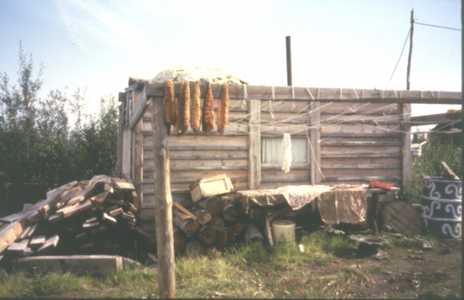 "Kéta-Bega" can be recognised as salmon month. It was the time in early summer when the fish swarmed up the river and could be preserved by handing out to dry or stored in ice caves - underground larders with a hut above, in the permafrost - both methods are still used today.
"Kéta-Bega" can be recognised as salmon month. It was the time in early summer when the fish swarmed up the river and could be preserved by handing out to dry or stored in ice caves - underground larders with a hut above, in the permafrost - both methods are still used today.
Body Calendar
Evenks, also Even and Yukaghir all had a system of counting the months on the body.
Here is an Evenk method:
- Sónaya = head, beginning of year
- Evrimira = left shoulder
- Íchán = left upper arm
- Bilyán = eft lower arm
- Unmú = space between knuckle and first finger joint
- Charátki = space between first and second finger joint
- Ogíkta = top of finger
the year has reached the middle and transfers to tip of finger of right hand and counts upward:
- Ogíkta
- Charátki
- Unmú
- Bilyán
- Íchán
- Tuktirimía
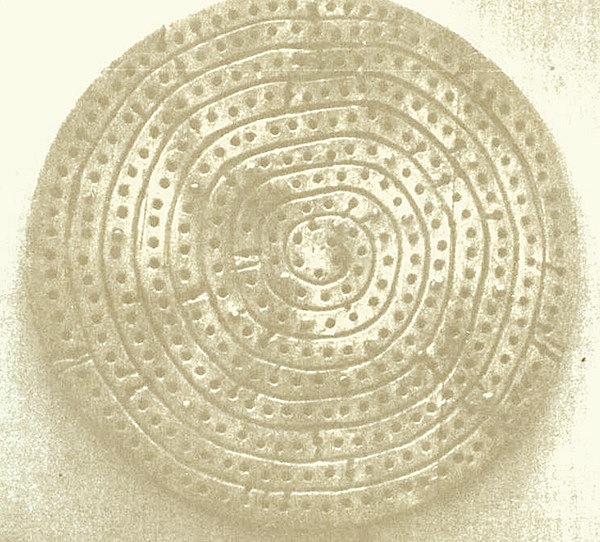 To keep a record of the calendar and mark off the days, they had wooden calendars - the evenks had a big round wooden calendar with holes for each day of the year.
The calendar was hung from one of the poles of the dyu, at the back along with the household guardian dolls. It was the responsibility of the man of the household to place a peg into the next hole on the calendar marking the day of the year.
To keep a record of the calendar and mark off the days, they had wooden calendars - the evenks had a big round wooden calendar with holes for each day of the year.
The calendar was hung from one of the poles of the dyu, at the back along with the household guardian dolls. It was the responsibility of the man of the household to place a peg into the next hole on the calendar marking the day of the year.
Origin Myth
The world was origninally very small - covered in water with not enough land to pasture reindeer. Peole complained to the Mammoth - Heli. The Mommoth wandered about in the water and found the Serpent - Dzhabdar. She persuaded her to help dry the world to make more land.
The Mammoth plunged her tusks into the bottom of the water and brought up clay, sand, stones, these became cliffs, mountains. The Serpend wriggled behind making rivers.
Then trees grew. But the trees and cliffs grew so high they could support the sky. They argued who would get there first. Seveki - God of the Upper World (Heaven) heard them and knocked down the cliffs and seized the trees so hey withered and died. Since then cliffs have crumbled and trees withered and died.
The Mammoth is also the Creator Mother of the Dolgan, where she walked - rivers formed, where she lay down, a lake was left. Finally she left for the Underworld with all her children.
Great Bear/Cosmic Elk
One day three hunters were getting ready for the hunt. The biggest boasted he would be first, the second had to carry the pot to cook it in, the third was the smallest and would have been the last, but when they saw the Elk (Helen) the biggest hunter run to the back and the smallest to the front - which is how you see them in the sky today - the Elk killed by her hunters - the middle one (double star) carrying the pot.
This story of the Plough or Ursa Major constellation is found in various versions across the Northern Hemisphere. It can be seen deicted on rock drawings dating to about 6,ooo years ago - they show the cosmic hunt around the celestial pole - so with the other mythical figures representing the stars and constellations they can be dated.
In Evenk legends, the hunter of the Elk was Main - who became God. In other versions the Hunter is Mangi, who is also a bear, and the bright star Arcturus, and the ancester of man. Finno-Ugrian legends have the Bear as God - Num, and as a skier chasing the Sun which the Elk has in her antlers - (but female elk do not have antlers) - the story really tells how the sun is captured and carried about the sky by the Elk who is killed and the sun then rises again in the morning - her daughter has survived and the hunt starts again across the night sky next evening. The hunt appears in rock drawings in Siberia, Scandivania, and Spain.
And Evenk story - which dates back in Siberia before the Evenk were there, tells of the Elk (Helen or Evlen) and her daughter (the little bear constellation) hunted by the Hero/God on skies - leaving his ski tracks (Cygnus the cross-shaped constellation of the Swan - after which the Milky Way appears split in two - like ski tracks). The Elk fled to the sea and become Heli the Mammoth but her daughter remained to be hunted again the next night.
The Mammoth link may explain why although the story is much the same to explain the constellation - you get an Elk carrying the sun in antlers she would not have - and in some versions a bear instead. More than 6,000 years ago the constelation looked a bit squarer than it does today - only five of the stars or in a related cluster together with Sirius in the southern part of the sky - as we are moving through that cluster. So as the centuries pass we see the constellation change its shape. It is very likely that it was originally a mammoth who was chased across the night skies, night after night, around the year, marking the night hours, and the seasons of the year. That explains the sun in the antlers - originally the mammoth's tusks, and also how after mammoths had disappeared from the daily scene, she was remembered as a large impressive shaggy beast so became the Elk or the Bear.
The Evenk universe had three different worlds, linked by the River, which runs into the sea of the Underworld - the entrance guarded by Kalir who was half Elk, half fish. (Not unlike the Northern goddess Hell or Hades half alive, half dead.)
The Middle World, Dulin Buga or Dunne, was where people live. The River - Engdekit - flowers from the morning Tyman-Itki in the east and the direction to go to the Upper world, on to the west, the Evening and Night Dolbon-Itki and the entrance to the Lower World, guarded by Kalir, half Elk half fish. To get there the shaman goes through a hold - this is what you see in front of you sometimes (central scotoma) - the shaman brought it on deliberately with the singing and dancing bringing on a trance state. Apart from shamans only the dead went to Bukit in the west - the Land of the Dead on the way to the Lower world - Khergu Buga in the north. Here the spirits of the dead were welcomed by the mistress of the dead and lived in Iron yurts. Here also were the khargi, half man half animal - the tribal totems. While the Middle World was lit by the Sun - Dylacha, the Lower World of ghosts was lit only dimly by a half-sun.
The Upper World, Ugu Buga, linked to Middle Earth where the river Engdekit when through a whirlpool and came up a hole, was were the souls (omi) were stored to recycling (people had more than one soul). Above it were the worlds of the heavenly beings. There is Evelen, the Elk - the Plough constellation. There is the wold of Ulgar, the Pleiades or Sieve. There is the Moon - Bega, there is Cholbon - the planet Venus - the morning and evening star. And overall all is the far south there is Main, (God).
The shaman
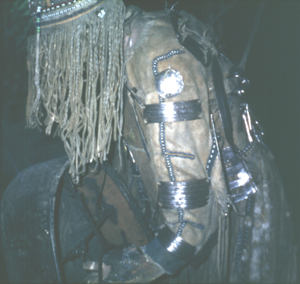 Shaman (or chaman or haman) is an Evenk work which is now an anthopological term. It meant "frenzied one". Our words charm, enchant, chant, etc. are from the same origin. Women shamans were called "utagen" which means "hearth (or fire) woman" and indicates the original importance and probably original separate functions of the women shaman - who could be more powerful than a man. This was not a profession you chose - it chose you and each clan needed a shaman as the shaman protected his people from harmful spirits and influences. The shaman had long uncombed hair as he kept the spirits of his people in his hair. Shamans went through a sort of initiation experience with illness and powerful dreams in which they were cut up by spirits and cooked in a chauldron. The meat was made into shashliks - the more shashliks they could make the greater the shaman - great shamans made up into nine shashliks, medium was about six, lesser shamans only about three - less than that meant failure unless they could get a contribution from another clan member. The body was re-assembled as a shaman with helper spirits. Then they had training and gradually assembled their ceremonial clothes and equipment. The tambourine, the coat cut in a long trailing point at the back and with fringes (showing its historical origin as animal skin) which was hung about with iron and copper charms representing the worlds which the shaman went to when in a trance, and the helping spirits, and an embroidered and iron extra skeleton over the whole outfit, coat, apron, boots, mits, for extra protection on the journey to the other worlds. Themits and boots were embroidered and shaped to look a bit like cloven reindeer hooves. The head was covered with an embroidered and decorated hood and the face concealed with fringes and a painted mask. Great shamans wore an iron crown with antlers. On the back of the coat were also rows of bells and whistles to make more of a noise as the shaman beat his reindeer-skin covered tambourine, which also had charms fastened inside it - (the beater was shaped to resemble the shape of the plough constellation), sang and danced into a trance.
Shaman (or chaman or haman) is an Evenk work which is now an anthopological term. It meant "frenzied one". Our words charm, enchant, chant, etc. are from the same origin. Women shamans were called "utagen" which means "hearth (or fire) woman" and indicates the original importance and probably original separate functions of the women shaman - who could be more powerful than a man. This was not a profession you chose - it chose you and each clan needed a shaman as the shaman protected his people from harmful spirits and influences. The shaman had long uncombed hair as he kept the spirits of his people in his hair. Shamans went through a sort of initiation experience with illness and powerful dreams in which they were cut up by spirits and cooked in a chauldron. The meat was made into shashliks - the more shashliks they could make the greater the shaman - great shamans made up into nine shashliks, medium was about six, lesser shamans only about three - less than that meant failure unless they could get a contribution from another clan member. The body was re-assembled as a shaman with helper spirits. Then they had training and gradually assembled their ceremonial clothes and equipment. The tambourine, the coat cut in a long trailing point at the back and with fringes (showing its historical origin as animal skin) which was hung about with iron and copper charms representing the worlds which the shaman went to when in a trance, and the helping spirits, and an embroidered and iron extra skeleton over the whole outfit, coat, apron, boots, mits, for extra protection on the journey to the other worlds. Themits and boots were embroidered and shaped to look a bit like cloven reindeer hooves. The head was covered with an embroidered and decorated hood and the face concealed with fringes and a painted mask. Great shamans wore an iron crown with antlers. On the back of the coat were also rows of bells and whistles to make more of a noise as the shaman beat his reindeer-skin covered tambourine, which also had charms fastened inside it - (the beater was shaped to resemble the shape of the plough constellation), sang and danced into a trance.
The Shaman Tent
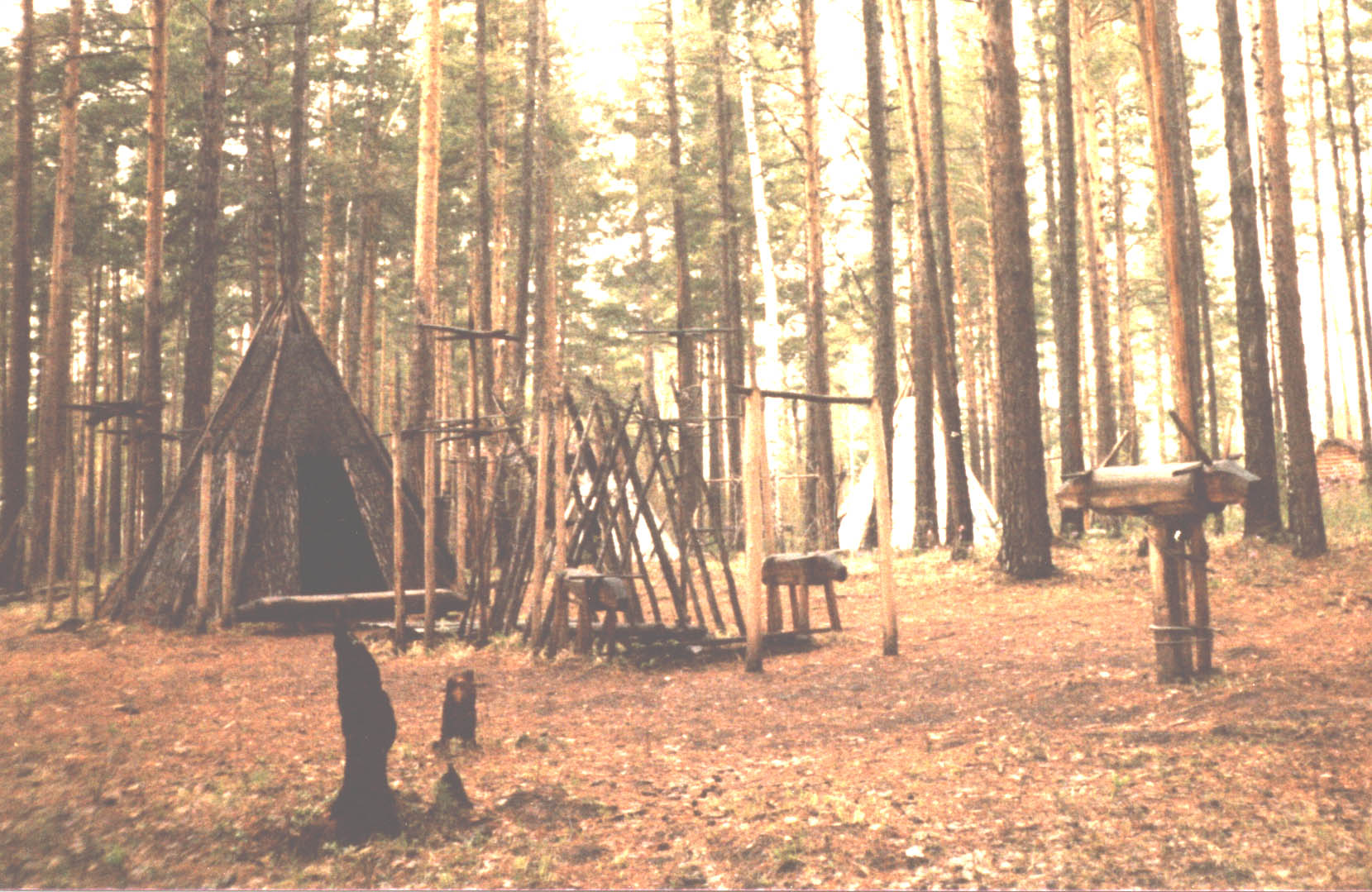 The shaman tent, new every time, was built while the shaman prepared and dispatched one of his kargi (spirits) to get advice on how the ceremony should go. Ceremonies were held to exorcise spirits causing disease, and other problems and also for major events. Evenks held two major annual rituals. One was the Shingkelevun (or Singkelevun, or Hingkelevun) which was before they went hunting for furry animals like sable, deer etc. The other was held to start the new year in spring and was to ask Eneken Buga, Mistress of the Universe to bring life to Nature and prosperity. This was the Yikenipke, and was held during the first new moon of spring - after the cuckoo was first heard.
The shaman tent, new every time, was built while the shaman prepared and dispatched one of his kargi (spirits) to get advice on how the ceremony should go. Ceremonies were held to exorcise spirits causing disease, and other problems and also for major events. Evenks held two major annual rituals. One was the Shingkelevun (or Singkelevun, or Hingkelevun) which was before they went hunting for furry animals like sable, deer etc. The other was held to start the new year in spring and was to ask Eneken Buga, Mistress of the Universe to bring life to Nature and prosperity. This was the Yikenipke, and was held during the first new moon of spring - after the cuckoo was first heard.
The tent (shevenchedek or sevenchedek or hevenchedek) was put up. In the centre next the hearth was a small larch tree representing the worldd tree Turu). The shaman tooke his place (Kumalan) on a white fur rung in the most hornoured part of the tent - Malu. On either side were weapons to fight evil spirits and representations of fish guards - pike and tench. Outside, behind the tent on the west side wooden stumps were hammered into the ground (onang) and trees stumps with roots in the ground (helget) representing Hergu Buga the river of the lower world.
On the east side of the tent, as you approached you saw the reindeer for the sacrifice tied to a Turu - spirit tree which was decrated with ribbons, white and red to the Earth spirits, black to the underworld spirits. The the Nelget, shaman tree of the Upper World, upside down with its roots in the air. Then you went through an avenue (Darpe)of live larch trees and carved wooden images of spirits including kalir - a giant wild reindeer god, salmon spirits. It represented Ugu Buga - the river of the Upper World. At the entrance, were larch trees over, roots outwards (opposite to trees on the west side) and on the threshold you stepped over a doubled headed pike.
The shaman gave a signal -calling like a bird for everyone to enter. Then the entrance was closed. Assistants robed the shaman - and prepared the tambourine. Ceremonies lasted for three days or more.
Evenk rituals with music are described in detail on this website.
Continues with the invasion from the west.
 The Yukaghir used dog sleds for transport (this is mentioned by Marco Polo). They hunted wild reindeer. In the autumn when the reindeer returned south from their summer pastures on the tundra - the Yukaghir would be waiting for them as they crossed a river and move in for the kill. They lived in small villages along the rivers. In half-underground houses in winter and large round tents in the summer.
The Yukaghir used dog sleds for transport (this is mentioned by Marco Polo). They hunted wild reindeer. In the autumn when the reindeer returned south from their summer pastures on the tundra - the Yukaghir would be waiting for them as they crossed a river and move in for the kill. They lived in small villages along the rivers. In half-underground houses in winter and large round tents in the summer. They had a pictorial writing system with which they recorded events and stories - and another writing system used by girls to court the men they fancied - an example is shown in the picture. Their boyfriend would move in with them and had to work for his father-in-law.
They had a pictorial writing system with which they recorded events and stories - and another writing system used by girls to court the men they fancied - an example is shown in the picture. Their boyfriend would move in with them and had to work for his father-in-law.
 Small children were attached to the reindeer backs in a device rather like the way children today are strapped into a car seat - similar shape etc. While babies were carried in a cradle very much like the car carriers for babies today. They were angled - had handles to carry them by. And they were padded with a disposable mattress of moss. The same sort of equipment was used by the Evenks of central Siberia.
Small children were attached to the reindeer backs in a device rather like the way children today are strapped into a car seat - similar shape etc. While babies were carried in a cradle very much like the car carriers for babies today. They were angled - had handles to carry them by. And they were padded with a disposable mattress of moss. The same sort of equipment was used by the Evenks of central Siberia. Even lived either in small tents like the Evenks, or in the larger chorama-dyu like the Yukaghirs. Up to the 18th century they still lived in the tradition winter houses by the coast - half underground with the entrance through the chimney hole. They built storehouses on platforms. Their clothes were the traditional Siberian fashions as worn also by the Yukaghir and Evenks and Dolgans. They had a similar clan structure of society which became mixed with clans of other peoples they encountered.
Even lived either in small tents like the Evenks, or in the larger chorama-dyu like the Yukaghirs. Up to the 18th century they still lived in the tradition winter houses by the coast - half underground with the entrance through the chimney hole. They built storehouses on platforms. Their clothes were the traditional Siberian fashions as worn also by the Yukaghir and Evenks and Dolgans. They had a similar clan structure of society which became mixed with clans of other peoples they encountered. 
 1991 Evenkia formed from Evenk and Karasnoyarsk as republic in the Russian Federation. The design of the national flag changed a few times.
1991 Evenkia formed from Evenk and Karasnoyarsk as republic in the Russian Federation. The design of the national flag changed a few times. The Palma (in Russian) - Utken (in Evenk) was the Evenk main piece of equipment, a weapon and a tool. It is like a big knife on a very long pole. The picture shows me with a palma in 1983.
The Palma (in Russian) - Utken (in Evenk) was the Evenk main piece of equipment, a weapon and a tool. It is like a big knife on a very long pole. The picture shows me with a palma in 1983. Three poles formed the main structure of the tent (called dyu) then other poles placed over them to make the round shape. This was covered with reindeer skin - or in summer, birchbark - sewn into sheets. A framework of wooden poles across the central fire were used to hand iron cooking pots and to dry clothes.
Three poles formed the main structure of the tent (called dyu) then other poles placed over them to make the round shape. This was covered with reindeer skin - or in summer, birchbark - sewn into sheets. A framework of wooden poles across the central fire were used to hand iron cooking pots and to dry clothes. Permanent store houses were built from logs and raised from the ground on pillars - out of reach of mice. Anyone passing by could take something out of someone else's store house, but there were expected to leave something in return. Exchange was the only currency and is still expected. (Although it can be a bit uneven when tourists find a camera or such missing and replaced by a fish).
Permanent store houses were built from logs and raised from the ground on pillars - out of reach of mice. Anyone passing by could take something out of someone else's store house, but there were expected to leave something in return. Exchange was the only currency and is still expected. (Although it can be a bit uneven when tourists find a camera or such missing and replaced by a fish). "Kéta-Bega" can be recognised as salmon month. It was the time in early summer when the fish swarmed up the river and could be preserved by handing out to dry or stored in ice caves - underground larders with a hut above, in the permafrost - both methods are still used today.
"Kéta-Bega" can be recognised as salmon month. It was the time in early summer when the fish swarmed up the river and could be preserved by handing out to dry or stored in ice caves - underground larders with a hut above, in the permafrost - both methods are still used today. To keep a record of the calendar and mark off the days, they had wooden calendars - the evenks had a big round wooden calendar with holes for each day of the year.
The calendar was hung from one of the poles of the dyu, at the back along with the household guardian dolls. It was the responsibility of the man of the household to place a peg into the next hole on the calendar marking the day of the year.
To keep a record of the calendar and mark off the days, they had wooden calendars - the evenks had a big round wooden calendar with holes for each day of the year.
The calendar was hung from one of the poles of the dyu, at the back along with the household guardian dolls. It was the responsibility of the man of the household to place a peg into the next hole on the calendar marking the day of the year. Shaman (or chaman or haman) is an Evenk work which is now an anthopological term. It meant "frenzied one". Our words charm, enchant, chant, etc. are from the same origin. Women shamans were called "utagen" which means "hearth (or fire) woman" and indicates the original importance and probably original separate functions of the women shaman - who could be more powerful than a man. This was not a profession you chose - it chose you and each clan needed a shaman as the shaman protected his people from harmful spirits and influences. The shaman had long uncombed hair as he kept the spirits of his people in his hair. Shamans went through a sort of initiation experience with illness and powerful dreams in which they were cut up by spirits and cooked in a chauldron. The meat was made into shashliks - the more shashliks they could make the greater the shaman - great shamans made up into nine shashliks, medium was about six, lesser shamans only about three - less than that meant failure unless they could get a contribution from another clan member. The body was re-assembled as a shaman with helper spirits. Then they had training and gradually assembled their ceremonial clothes and equipment. The tambourine, the coat cut in a long trailing point at the back and with fringes (showing its historical origin as animal skin) which was hung about with iron and copper charms representing the worlds which the shaman went to when in a trance, and the helping spirits, and an embroidered and iron extra skeleton over the whole outfit, coat, apron, boots, mits, for extra protection on the journey to the other worlds. Themits and boots were embroidered and shaped to look a bit like cloven reindeer hooves. The head was covered with an embroidered and decorated hood and the face concealed with fringes and a painted mask. Great shamans wore an iron crown with antlers. On the back of the coat were also rows of bells and whistles to make more of a noise as the shaman beat his reindeer-skin covered tambourine, which also had charms fastened inside it - (the beater was shaped to resemble the shape of the plough constellation), sang and danced into a trance.
Shaman (or chaman or haman) is an Evenk work which is now an anthopological term. It meant "frenzied one". Our words charm, enchant, chant, etc. are from the same origin. Women shamans were called "utagen" which means "hearth (or fire) woman" and indicates the original importance and probably original separate functions of the women shaman - who could be more powerful than a man. This was not a profession you chose - it chose you and each clan needed a shaman as the shaman protected his people from harmful spirits and influences. The shaman had long uncombed hair as he kept the spirits of his people in his hair. Shamans went through a sort of initiation experience with illness and powerful dreams in which they were cut up by spirits and cooked in a chauldron. The meat was made into shashliks - the more shashliks they could make the greater the shaman - great shamans made up into nine shashliks, medium was about six, lesser shamans only about three - less than that meant failure unless they could get a contribution from another clan member. The body was re-assembled as a shaman with helper spirits. Then they had training and gradually assembled their ceremonial clothes and equipment. The tambourine, the coat cut in a long trailing point at the back and with fringes (showing its historical origin as animal skin) which was hung about with iron and copper charms representing the worlds which the shaman went to when in a trance, and the helping spirits, and an embroidered and iron extra skeleton over the whole outfit, coat, apron, boots, mits, for extra protection on the journey to the other worlds. Themits and boots were embroidered and shaped to look a bit like cloven reindeer hooves. The head was covered with an embroidered and decorated hood and the face concealed with fringes and a painted mask. Great shamans wore an iron crown with antlers. On the back of the coat were also rows of bells and whistles to make more of a noise as the shaman beat his reindeer-skin covered tambourine, which also had charms fastened inside it - (the beater was shaped to resemble the shape of the plough constellation), sang and danced into a trance.
